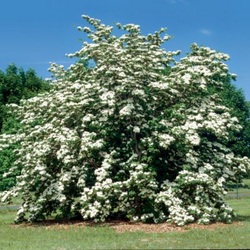 This is the idea. As the outer corner focal points, we narrowed our Collins corners tree choice to Cornus kousa 'Milky Way.' Milky Way dogwood has a height of about 20 feet, and a spread of about 15-20 feet, with a broad columnar shape, eventually widening at the crown to a more horizontal habit, and the specimens we selected branch low on their trunks. It features white flowers, red fruit, and dark green summer foliage which turns to a good wine color in the fall. This cultivar was introduced by Wayside Gardens for the 2007 season. It was selected for its abundant, long-lasting, and showy blooms, followed by a heavy crop of large, attractive, strawberry-like fruits (loved by birds). It also features very ornamental bark. The vigorous tree flowers in June. It is adaptable to full sun and most soils, and is resistant to many pests and diseases, including Anthracnose. While it requires moderately evenly moist soil, once it is established this spring in our clay soil, it should be tolerant of relatively dry summer conditions. We've bought two trees from Chapon's today (plus 14 other shrubs--sadly we didn't get a discount. I hope they decide to do this in the future, either for garden clubs, and/or for Phipps members and/or for Botanic Garden members), which will be delivered next Friday, and installed by Blackridge's own Tom Fossick and his landscaping crew (412-377-2790 or 412-829-1812) shortly thereafter. We can use some help schlepping water so that we give our new trees and shrubs a good start, so if you'd like to help, please let us know.
0 Comments
The qualities we enjoy in a winter landscape have much to do with the form, structure and height of a plant, as well as its interesting bark texture, and colorful fruit, berries, or seeds. Needle and broadleaf evergreens, such as hollies (especially natives), spruces, pines, and false cypresses (especially the Hinoki false cypresses) are natural choices, and here are a few others to consider:
I am becoming interested in some of the newer eastern hemlock (Tsuga canadensis—Pennsylvania’s state tree and a native species) miniature cultivars, some of which are tiny and very slow growing, and suitable for many areas of Blackridge yards. ‘Abbott’s Pygmy,’ which has dark green pointy leaves which flush into light green in the spring only grows to 18 inches in height. ‘Summer Snow’ features ivory growth, which becomes deep green, on a hemlock which grows to a mature height of 5-10 feet. I found some online nurseries selling up to 35 different small cultivars of T. canadensis. The native red osier dogwood (Cornus sericea ‘Allemans’ and other cultivars) is a very hardy spreading (6’-10’ high by 5’-10’ spread) shrub with dark blood-red bark, which looks beautiful against a backdrop of fresh white snow. Although it can become a little invasive, I have a soft spot for our native bayberry (Myrica pensylvanica), which, like the dogwood, has a spreading habit (6’ high by the same spread). Its glossy, aromatic foliage complements its waxy, gray berries, which are used to scent candles. The shrub is also drought tolerant and deer-resistant, although birds love its berries. Another easy-to-grow native, the American cranberrybush viburnum, has some cultivars (V. trilobum ‘Compactum,’ ‘Alfredo’) which grow to only about half the size of the species. The mature plant is rounded and measures about 6’ tall by 4’ wide. In the winter its masses of red berries serve as a source of food for wildlife, and look lovely in the winter landscape. For more options on winter interest you can visit http://www.indyzoo.com/pdf/Plants_with_Winter_Interest.pdf |
Author,
|
Copyright © 2020. All web site design, text, graphics, the selection and arrangement thereof, and all software are Copyright protected under the copyright laws. Any use of materials on this website, including reproduction, modification, distribution or republication, without the prior written consent of Blackridge Garden Club, is strictly prohibited.
 RSS Feed
RSS Feed